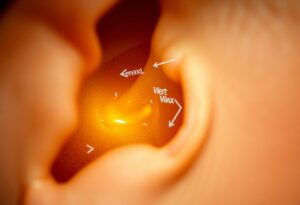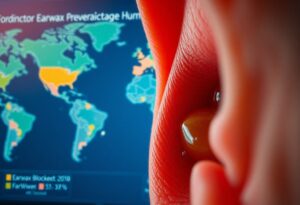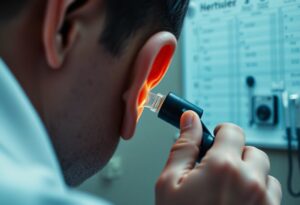Do blocked ears leave you feeling frustrated and searching for relief? Your search ends here!
This comprehensive guide to microsuction ear wax removal will restore your comfort and bring back crystal-clear hearing. Gone are the days of outdated techniques that risk pain or harm to your sensitive ear canal. Microsuction offers a gentle, accurate approach that loosens and extracts excess ear wax effortlessly.
Understanding Microsuction: The Science Behind Safe Ear Wax Removal
Cerumen, commonly called ear wax, represents a natural secretion from specialized glands within your ear canals. This substance serves multiple protective functions, including ear lubrication and creating a barrier that captures dust, particles, and harmful bacteria before they reach your eardrum. While cerumen plays a vital role in ear health, excessive accumulation creates blockages that cause significant discomfort.
Accumulated ear wax hardens over time, becoming impacted and creating that familiar blocked sensation. This condition produces muffled hearing, feelings of fullness, and can trigger dizziness or ear pain. Several factors increase blockage probability, including individual ear canal shape, wax consistency variations, and regular use of hearing devices or protective earplugs.
Attempting ear wax removal using cotton swabs or similar objects pushes wax deeper into the canal, worsening blockages and potentially damaging delicate ear structures. This reality makes professional, safe ear wax removal methods like microsuction the smart choice for addressing these problems.
Conventional Ear Wax Removal Techniques
Historically, people relied on conventional approaches for ear wax extraction, including ear drops, syringing, and ear irrigation. While these techniques work for some individuals, they carry notable limitations and potential complications.
- Ear drops typically contain oils or specialized solutions designed to soften hardened wax, theoretically making removal easier. This process often requires several days to show results and frequently fails to completely eliminate blockages. Some people experience irritation or allergic reactions from these chemical solutions.
- Syringing, alternatively called ear irrigation, uses a water or saline-filled syringe to flush wax from the ear canal. This technique can prove effective when performed correctly but demands precision and should only be administered by qualified professionals. Improper execution risks damage to sensitive ear structures.
Microsuction represents a contemporary, highly effective ear wax removal method that has gained widespread acceptance among healthcare professionals. This technique employs a specialized suction device equipped with a miniature suction tube and integrated lighting system. The suction tube gently and precisely extracts excess ear wax without requiring water or liquid solutions.
Professional microsuction procedures involve trained healthcare specialists using the suction device to carefully remove ear wax from the canal. The entire process occurs under direct visual guidance using microscopes or otoscopes, ensuring maximum accuracy and safety. This approach means only problematic wax gets removed while healthy wax remains undisturbed.
Microsuction ranks among the safest ear wax removal methods available, minimizing injury risks to ear canals or eardrums. Procedures typically complete quickly and patients tolerate them well, with most people experiencing immediate relief from blocked sensations. This treatment suits people of all ages, including children and hearing aid users.
Key Advantages of Microsuction Ear Wax Removal
Microsuction ear wax removal provides numerous benefits compared to traditional approaches, establishing it as the preferred option for many patients. These advantages include:
Accuracy and Protection: Microsuction enables precise wax removal under direct visual control, significantly reducing injury risks to delicate ear structures.
Instant Relief: While other methods require days to soften wax, microsuction delivers immediate relief from discomfort and blocked feelings.
Comfortable Experience: Patients generally tolerate the procedure well with minimal discomfort, often describing it as a gentle suction feeling.
Dry Procedure: Microsuction eliminates water or liquid requirements, making it perfect for people with ear infection histories or those preferring to keep ears dry.
Universal Application: Microsuction works safely for all ages, including children, hearing aid users, and people with narrow or unusually shaped ear canals.
Step-by-Step Microsuction Procedure
Microsuction ear wax removal follows a systematic approach that includes these stages:
Initial Examination: Healthcare professionals examine your ears using otoscopes or microscopes to evaluate wax buildup severity and determine the best treatment approach.
Pre-treatment Preparation: Before beginning, professionals may apply cerumenolytic solutions to soften ear wax, facilitating easier removal. This step depends on wax consistency and may not always be required.
Suction Treatment: Using the specialized suction device, healthcare professionals carefully insert the suction tube into your ear canal and gently extract excess wax. The entire procedure occurs under direct visual guidance, ensuring both precision and safety.
Final Assessment: After completing microsuction, professionals re-examine your ears to confirm complete wax removal. If needed, additional steps address any remaining wax deposits.
Getting Ready for Your Microsuction Appointment
Proper preparation ensures successful and comfortable microsuction appointments. Follow these preparation guidelines:
Share Medical History: Inform healthcare professionals about any ear infection history, perforated eardrums, or other ear-related conditions before treatment. They will factor these considerations into your safety and comfort planning.
Clean External Ears: Before your appointment, gently clean your outer ear areas with a damp cloth. This removes visible debris and helps professionals visualise your ear canals more effectively.
Addressing Common Microsuction Myths
Despite proven effectiveness and safety, several misconceptions surround microsuction ear wax removal. Let’s clarify these misunderstandings:
Myth: Microsuction Causes Pain: Microsuction actually provides comfortable treatment with minimal discomfort. Most patients describe the sensation as gentle suction, similar to a quiet vacuum cleaner.
Myth: Microsuction Harms Ears: When performed by trained professionals, microsuction represents a safe procedure that minimises ear canal or eardrum injury risks. Healthcare professionals use microscopes or otoscopes to visualise ear canals and ensure precision.
Myth: Microsuction Removes All Ear Wax: Microsuction targets excess or impacted wax causing blockages or discomfort. Small amounts of healthy ear wax remain intact, as they’re necessary for proper ear health.
Post-Treatment Care for Healthy Ears
Following microsuction ear wax removal, these aftercare practices maintain clear and healthy ears:
Avoid Object Insertion: Never insert cotton swabs, fingers, or other objects into your ears. This action pushes wax deeper into ear canals and increases blockage or injury risks.
Maintain Dry Ears: Avoid swimming or submerging ears in water for at least 24 hours after treatment. Moisture can cause irritation or infection, particularly while ear canals heal.
Use Protective Earplugs: When engaging in activities exposing ears to excessive noise or water, such as swimming or concerts, use earplugs to protect ears from debris and moisture.
Schedule Regular Monitoring: Prevent future blockages and maintain optimal ear health by scheduling regular check-ups with healthcare professionals such as Ear Wax removal Devon who can monitor ear wax buildup and provide necessary treatments or cleanings.




1 comment
A WordPress Commenter
Hi, this is a comment.
To get started with moderating, editing, and deleting comments, please visit the Comments screen in the dashboard.
Commenter avatars come from Gravatar.
Comments are closed.